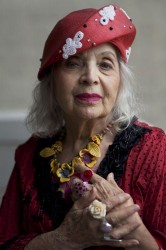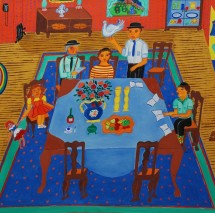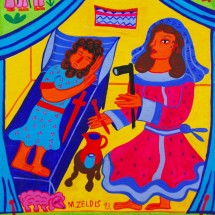Malcah Zeldis (American, b. 1931)

August 2012, photo courtesy of Advanced Style a blog by Ari Seth Cohen
Malcah Zeldis was born Mildred Brightman in the Bronx, New York, in 1931, and soon after her family moved to Detroit. After graduating from high school in 1948, Zeldis moved to a kibbutz (agricultural community) in Israel on a quest to learn more about her family’s roots. It was there that she met and married Hiram Zeldis and began to paint. When Zeldis and her family moved back to New York a decade later she began to lose confidence in her art and gave up painting for the next ten years, focusing instead on her family. In the early 1970s, Zeldis enrolled in Brooklyn College as an Early Childhood Studies major. The year 1974 marked her graduation, divorce, and return to painting. Since then Zeldis’s art career has gained steady momentum and her artwork has been exhibited in museums ranging from the Jewish Museum to the Smithsonian American Art Museum. Zeldis has also collaborated with her daughter, Yona Zeldis McDonough, a Vassar alumna (class of 1979), to illustrate and write children’s books ranging in subject from biblical stories to famous historical figures such as Anne Frank. The Frances Lehman Loeb Art Center holds in its collection an original painting from the book Eve and Her Sisters; Women of the Old Testament. The painting depicts Jael, a Kenite woman, looming above the sleeping Sisera, a chieftain of the oppressive Canaanites, with a tent pin and hammer in hand.
In a 2012 interview Zeldis describes how when fighting cancer she had difficulty painting so she turned to “dressing up” in order to get through the worst of her pain. She spent hours picking out her outfits, applying make-up, and matching jewelry to her ensemble. Zeldis went on to state that she is very “involved in color and form” and her art, her house, and her wardrobe reflects this, almost as if she is living within one of her paintings. Her paintings are also autobiographical in subject as she can be “whatever [she] wants.” She often includes a black cat to represent her “bad” self, or a white cat as a stand-in for her “good” self. Zeldis’s paintings are revered for their abundance of bold color, imagination, figuration, narrative, and personal meaning.
- Untitled, 1984
- Jael, Defender of Israel from Eve and Her Sisters: Women of the Old Testament, 1994


